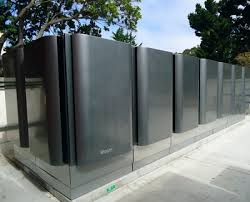Recently Home Depot announced that they were installing fuel cells in up to 10 of their Long Island locations. The fuel cells which power up to 90% of a typical Home Depot's needs are being installed by Bloom Energy, one of the premier suppliers of fuel cell technology. This is not the first time that Home Depot has tried fuel cells. With incentives from LIPA (Long Island Power Authority) Home Depot tried fuel cells years ago with the results being iffy, due to the short life span of the fuel cells. However, much has changed, in recent times; the technology has improved significantly and continues to do so rapidly. Costs are coming down and incentives are available.
A fuel cell is a device that converts the chemical energy from a fuel into electricity through a chemical reaction of positively charged hydrogen ions with oxygen or another oxidizing agent. Fuel cells are different from batteries in that they require a continuous source of fuel and oxygen or air to sustain the chemical reaction, whereas in a battery the chemicals present in the battery react with each other to generate an electromotive force (emf). Fuel cells can produce electricity continuously for as long as these inputs are supplied.
Fuel cells offer a variety of benefits compared to traditional power generators. They are generally more fuel-efficient, operate with very little noise and produce no harmful emissions at point of use (fuel cells which use renewable hydrogen as fuel produce only water). They have no moving parts and are thus easy to maintain. In addition to electrical power, they produce high-quality heat which can be used for heating (or to drive refrigeration cycles for cooling), improving the overall efficiency of fuel use.
In a 2015 internal report, Home Depot said it had installed Bloom Energy fuel cells in 81 of its stores, cutting emissions by 30% and contributing (along with solar panels) to a 17% reduction in electricity consumption from the grid over the past three years. The company also uses more than 200 hydrogen fuel-cell-powered fork lifts that do not require recharging. The forklift fuel provided by Plug Power. Other companies currently employing fuel cell technology are Apple Computer, Stop & Shop, Google, Walmart, and Yahoo!
Charlie Fox, Bloom Energy’s director of East Coast regulatory affairs and business development states about Bloom Energy’s fuel cells: "We are about 40 percent more efficient than [traditional power] generators that are being replaced “ We reduce CO2 emissions by about 40 percent, eliminate ... [sulfur and nitrogen oxides], and it’s a very energy dense technology with a very small footprint.”
Fuel cells are relatively small, and do not take up that much space in comparison to solar and wind alternatives. Aesthetics are not nearly as much of an issue, and in the case of Home Depot, I did not hear of any opposition from the local community.
If things keep moving along this way fuel cells may just do an end around, on both Solar and wind power or certainly they could become good buddies working in harmony with each other.






